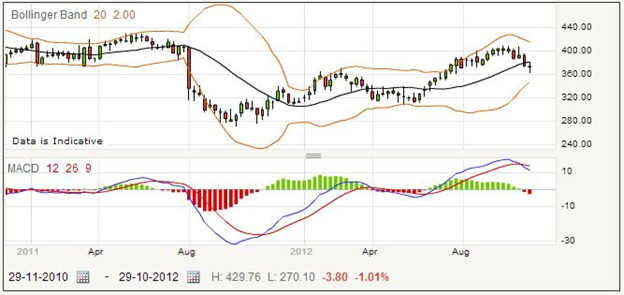Amlin Fundamentals
Amlin is a company that provides insurance cover through Lloyd’s. This means volatility, and susceptibility to price variations due to disasters, and this makes it particularly interesting if you “trade the news” in your spread betting.

This weekly price chart, for instance, shows the effect of the Fukushima earthquake in 2011, in which it suffered £500 million in claims. Amlin was also involved in the Costa Concordia disaster, the ship that sank off the Italian coast in January 2012, but not to a large extent.
Insurance protection through Lloyd’s of London involves wealthy people or companies, historically known as “names”, staking their money in return for receiving premiums. As the amounts of insurance that are available at Lloyd’s can be enormous, anyone with modest means is not allowed to take part directly. Lloyd’s provides primary insurance and reinsurance protection, which latter is when someone who has already underwritten the risk will seek others to share in the risk in return for some of the premium.
There are currently about 80 “names”, which nowadays are not so much wealthy individuals as syndicates which provide capital from investment companies, specialist investors, and other insurance companies, as well as individuals. This is of necessity, as insurance payouts can be so high that not many are wealthy enough to cover them by themselves.
The name Amlin comes from the companies which merged in 1998, Angerstein Underwriting, and Murray Lawrence Insurance, giving the initials AML, and “IN” comes from insurance. It has branches in the UK, France, Bermuda, Singapore, and the Benelux countries. In addition to generating money from receiving premiums, Amlin gets investment returns from its assets which are held in Lloyd’s trust funds. Its balances are worth several billion pounds sterling.
The price of Amlin shares will vary depending on the perceived risks it takes and the occurrence of disasters, so while you may expect the price to be a general uptrend from progressively increasing profits, there is always a chance of a setback following a major news event.
Amlin Rolling Daily: How to Spread Bet on Amlin shares?
Amlin can be quite a volatile stock. Suppose you believe that it is going to fall in value in the next few days, you might want to place a sell bet, going short at £4.50 per point. The current quotation for a rolling daily bet is 373.07 – 374.94, so your spread bet would be placed at 373.07.
By way of example, assume that the price falls to a level of 321.62 – 323.49, and you decide to close your trade and collect your winnings. You would work out your profit like this. The starting price for your bet was 373.07. You closed it when the buying price was 323.49. That means you have gained 373.07 minus 323.49 points, which is 49.58 points. With your stake of £4.50 per point, your winnings amount to £223.11.
But many times when you’re trading on the financial markets, you will find that the price does not go the way you anticipate. Suppose you placed the same bet, but this time the stock price goes up. You might decide to cut your losses when it reaches a level of 396.26 – 398.13. This time your closing price would be 398.13. Taking away the opening price of 373.07, you find that you have lost 25.06 points. For your chosen stake, this would amount to £112.77.
One way that many spread traders use to keep their losses down is to set a stoploss order when they take out the bet. This helps if you cannot be watching the markets all the time, as it instructs your spread betting provider to close your losing bet for you if it reaches a certain amount. With a stop loss order, you might find that this spread trade would have been closed at 387.65 – 389.52. With a closing price of 389.52 and the same opening price of 373.07, you would have lost 16.45 points. Your losses would have been kept down to £74.03.
Amlin Quarterly Futures Bet
Looking a few weeks ahead, you might think that the share price of Amlin will continue to rise, and want to place a spread bet on that notion. The current quotation for a far quarter spread bet is 374.07 – 378.58, so you could decide to bet £3 per point at the buying price of 378.58.
Suppose that the price goes up to 436.23 – 440.51, and you decide to close your spread trade and collect your profits. As it was a long bet, it closes at the lower of the two prices, the selling price, which is 436.23. Figuring out how much you have gained, 436.23 minus 378.58 is 57.65 points. With a wager of £3 per point, your profit is £172.95.
Even though this is a quarterly futures style bet, you can close it at any time if it goes against you and you do not have to wait until the expiration. Suppose the price suddenly dropped to 328.46 – 332.62. If you close the bet now, to avoid further losses, the closing price would be 328.46. 378.58 less 328.46 is 50.12 points. With a stake of £3 per point, this bet closes for a loss of £150.36.
As it can be hard to keep an eye on the markets at all times, many spread betters decide to use a stop loss order, instructing their broker to close a losing trade once a certain price is reached. If in this case you have placed a stop loss order, you might find that the wager would be ended at a quoted price of 336.13 – 340.25. Your starting price was 378.58, as before, but this time the closing price for this losing bet is 336.13. Taking one away from the other, you have lost a total of 42.45 points. Multiplying by £3, your loss this time is £127.35.